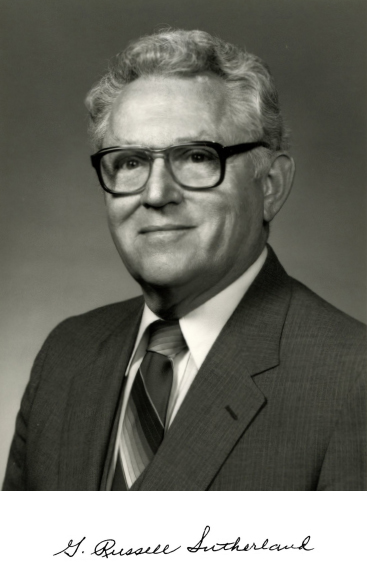1923–2014
Elected in 1984
“For outstanding contributions to agricultural mechanization resulting in mankind’s assurance of food and fiber to the end of this century.”
BY RON LEONARD
GLENN RUSSELL SUTHERLAND’s distinguished career with Deere & Company began in 1949 after graduation with a master’s degree in agricultural engineering with honors from the University of Wisconsin.
Russ spent the majority of his career in factory product engineering units of Deere & Company at Ottumwa and Des Moines, Iowa. His uncanny ability to conceive improvements to the hay and forage harvesting products earned him numerous patents and distinguished him at Deere’s Ottumwa Works. These skills earned him management positions with responsibility for the design of several major machine lines manufactured there.
In 1963 he received a promotion and transfer to the Deere Des Moines Works as senior division engineer for cotton harvesters, and soon was promoted to manager, product engineering, for all products at that unit. Deere had long trailed International Harvester in sales of cotton pickers and strippers. Under Russ’s leadership the Des Moines Works cotton harvesting machines rapidly improved in performance and durability to become market leaders over the competition.
Russ oversaw a broad range of products, from cotton pickers and strippers to adjustable-width row unit corn heads, farmstead grain dryers, stack wagons for hay harvesters, new
tillage implements, and row unit heads for combines that harvested soybeans. Product sales and market share records reached new heights. Farming practices were changing rapidly as farmers responded to the challenge to increase production and adjusted their farming practices as required. During his 28 years at the Ottumwa and Des Moines units Russ held 27 patents for agricultural equipment.
His leadership extended beyond specific product designs. He was also a great developer of managerial talent. Engineers who worked in Deere’s Ottumwa and Des Moines units benefited from his direct influence. They learned that his personality was unassuming and his guidance exemplified humility and gentleness. Summed up, his approach was just to state the facts clearly and honestly, then expand your thinking to consider new and different approaches to the design.
In 1977 Russ was appointed director of product planning at the Deere & Company Worldwide headquarters in Moline. His successful experiences with products at Deere units were put to good use in this assignment. In 1984 he was appointed vice president, engineering, and in April 1986 he assumed the position of vice president, engineering and technology.
During his time at Deere & Company, Russ championed the movement to desktop computing systems for product engineering functions. During the 1970s and 1980s, desktop digital design software and hardware underwent revolutionary changes as new modeling and analysis software were linked together. His leadership ensured that Deere engineering systems were state of the art.
Russ brought insight rather than information to the job. He was challenging but not demanding, practiced leadership with a smile, was an innovator not a follower, and was a mentor for both product and people development. His election to the NAE in 1984 was a fitting recognition of his accomplishments. He also served as a director of the American National Standards Institute.
The Deere & Company bulletin announcing Russ’s retirement in 1987 included the following summary of his contributions to the company: “Each of us in our career hopes to make
a positive difference in the Company through our efforts. Russ Sutherland is one who has made a positive difference. His influence has been felt in new product programs, development of engineering computer networks and systems, and the encouragement of entrepreneurial efforts at selling manufacturing technology developed within John Deere. Those of us who have worked with Russ know how much his wise counsel is sought and respected.”
His 90 years of life began in his parents’ farm home in Waukau, Wisconsin, on December 20, 1923, and ended with his death on June 11, 2014, at home in Mariposa, California, surrounded by his family. His life journey included attendance at Foote Rural School (a one-room schoolhouse) and graduation from Berlin, Wisconsin, High School. While working his way through the University of Wisconsin, his engineering studies were interrupted during World War II when he was called to active duty. He finished Midshipman School in Ithaca, New York, in March 1945 and married his high school sweetheart Leone there before reporting to a Miami naval base. Following his tour of duty as an engineering officer on board a ship in the Pacific they were reunited at the University of Wisconsin when Russ resumed his engineering studies.
After retirement from Deere in 1987, he and Leone moved to their dream home in Bella Vista, Arkansas, where he served on the property owners association board of directors and enjoyed golfing and boating. In 2000 they moved to Mariposa, where he volunteered for the Museum and History Center and was a member of the American Legion. He enjoyed traveling, gardening, working with tools to repair things, and researching the genealogy of his Scottish ancestry. Their family included sons and daughters-in-law Keith and Nancy Sutherland of Cedar Rapids, Iowa, and Glenn and Kathy Sutherland of Midpines, CA, five grandchildren, and nine great-grandchildren.
In remembering him at his death his family wrote, “Throughout this 90 year journey, there has been one constant: the character of Russ Sutherland. Despite his many achievements, he always has exemplified humility, gentleness, and above all, integrity. He always put family first, despite the







